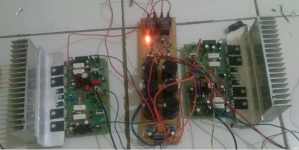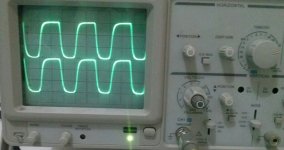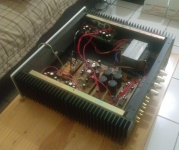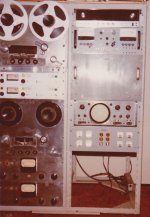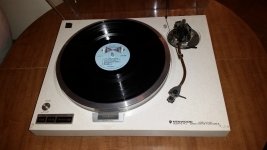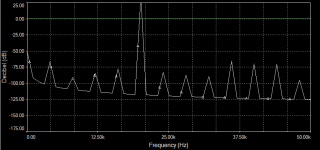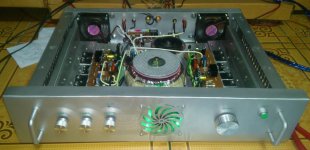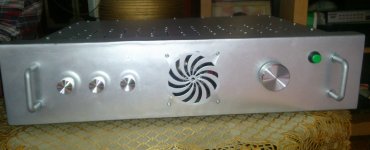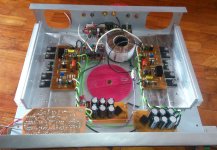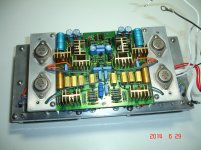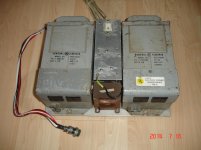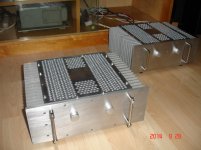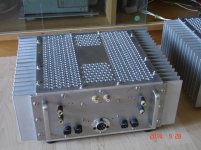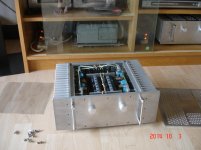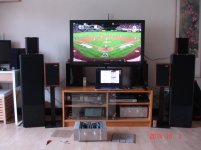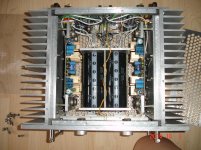Member
Joined 2009
Paid Member
This is my first power amplifier started when I was in high school; the amp was built from 1966 to 1968.
Really cool !
Hafler 500 rebuild
A brief history of a recent rebuild project: To begin I picked up a well used Hafler DH-500 off an auction site.
It was in bad shape and looked like it had seen some heavy band or DJ use. One large cap had been replaced and an output mosfet had been replaced with a generic. Still, it powered up and sounded ok.
Next I added an old set of Musical Concepts PA-3B boards. But I found that I couldn’t bias it properly because of the generic mosfet. Matched sets of Hitachi mosfets don’t exist anymore, so I shipped it to Musical Concepts and it updated with matched Exicon mosfets and a pair of new PA-3E boards. I had them swap over my Blackgate caps from the old boards…can’t lose those.
Once back home, I went ahead and removed the DC relay and replaced the caps with new 39,000uf 100V versions and rewired everything in a dual mono arrangement. That’s 156,000uf of storage, heh. Yes it’s only a single transformer and not true dual mono but it’s close enough for me. I replaced the diode bridges with IXYS 600V versions. Voltages are now exact at 92.3V per channel.
Finally, I added some pebble black paint to the cover and a NOS faceplate. Final result is a new looking amp and rock solid 255 watt+ per channel. The mods give it a 3D clarity with pinpoint imaging at all volumes, bass is taut and correct with lifelike dynamics. I’ve used Musical Concepts mods since the late ‘80s and the results are always very worthwhile.
A brief history of a recent rebuild project: To begin I picked up a well used Hafler DH-500 off an auction site.
An externally hosted image should be here but it was not working when we last tested it.
It was in bad shape and looked like it had seen some heavy band or DJ use. One large cap had been replaced and an output mosfet had been replaced with a generic. Still, it powered up and sounded ok.
An externally hosted image should be here but it was not working when we last tested it.
Next I added an old set of Musical Concepts PA-3B boards. But I found that I couldn’t bias it properly because of the generic mosfet. Matched sets of Hitachi mosfets don’t exist anymore, so I shipped it to Musical Concepts and it updated with matched Exicon mosfets and a pair of new PA-3E boards. I had them swap over my Blackgate caps from the old boards…can’t lose those.
Once back home, I went ahead and removed the DC relay and replaced the caps with new 39,000uf 100V versions and rewired everything in a dual mono arrangement. That’s 156,000uf of storage, heh. Yes it’s only a single transformer and not true dual mono but it’s close enough for me. I replaced the diode bridges with IXYS 600V versions. Voltages are now exact at 92.3V per channel.
An externally hosted image should be here but it was not working when we last tested it.
Finally, I added some pebble black paint to the cover and a NOS faceplate. Final result is a new looking amp and rock solid 255 watt+ per channel. The mods give it a 3D clarity with pinpoint imaging at all volumes, bass is taut and correct with lifelike dynamics. I’ve used Musical Concepts mods since the late ‘80s and the results are always very worthwhile.
An externally hosted image should be here but it was not working when we last tested it.
Last edited:
Really cool !
This was my sound system in 1979. My turntable is on slides behind the large panel on the right. A few years later I bought a Kenwood KD-600, SME arm and Shure V15 Type-IV-Cartridge.
Attachments
A brief history of a recent rebuild project: To begin I picked up a well used Hafler DH-500 off an auction site. ... I’ve used Musical Concepts mods since the late ‘80s and the results are always very worthwhile.
An externally hosted image should be here but it was not working when we last tested it.
And I thought I was the only one who sees gold in those old dance hall amps.
I'll have to give that "multiple diode bridge" a try.
Yes, I intend to build it as solid as I can.
Attach photographs to show the inside structure of it and the components in my living room.
Just cleaned it couple months ago so it looks shining still.
Attach photographs to show the inside structure of it and the components in my living room.
Just cleaned it couple months ago so it looks shining still.
Attachments
Awesome leach build , MUCH better than most. Triple OP is the only way to go, took me over 2 years to realize this.
OS
Hello OS,
Could you please advice what does " Triple OP" stand for?
John
I think he means triple output.
Does triple output mean 3pairs in the final part of the output stage
or
a combination of pre-driver, driver and output device?
Go look at Roender's amp.
He has used a triple stage with a 3pair for the output.
That definitely qualifies as a triple.
Does triple output mean 3pairs in the final part of the output stage
or
a combination of pre-driver, driver and output device?
Go look at Roender's amp.
He has used a triple stage with a 3pair for the output.
That definitely qualifies as a triple.
Attach photographs
Likely to sound a lot better than your class D integrated with dual triode valve input stage

(Philishave 908)
Here's mine. Version 2 of my Class AB ThermalTrak power amp module. Version 1 was posted sometime in 2005 (too many projects, haha).
PCB is 250mm X 75 mm.
Nothing exotic but decent parts used throughout....
4 output pairs for up to 200W/8R output (100W as shown)
100V 105C high temp low esr electrolytics
Silver mica caps for the high freq caps
Wima film caps for decoupling
Mills MRA05 low inductance emitter resistors
Onboard output delay, dc sensing and thermal shutdown
Keratherm White 86 thermal tape
Power and Output connectors are locking Molex Minifit Jr types. Screw/spade terminals are a big no-no here at work. LED color is not mentioned, heh.
Pictures:
1) Overall picture of board
2) Input/VAS detail showing how input TO92 pairs and VAS cascode pairs are thermally connected
3) Output stage showing individual base resistors and Wima 0.68uF MKC decoupling cap
Hello Arius,
Excellent design and works!
A good design always looks beautiful and makes people feel comfortable.
John
Very beautiful construction.
Respect for the laborious task of the perforated plate
All for better air flow and heat sinking
John
I think he means triple output.
Does triple output mean 3pairs in the final part of the output stage
or
a combination of pre-driver, driver and output device?
Go look at Roender's amp.
He has used a triple stage with a 3pair for the output.
That definitely qualifies as a triple.
Hello Andrew,
Thanks a lot for your kind answer.
It sounds to me that triple stage (pre-driver, driver and output) is the better design for bi-polar power amp, isn't it?
John
Likely to sound a lot better than your class D integrated with dual triode valve input stage
(Philishave 908)
You are absolutely right!
John
- Home
- Amplifiers
- Solid State
- Post your Solid State pics here
